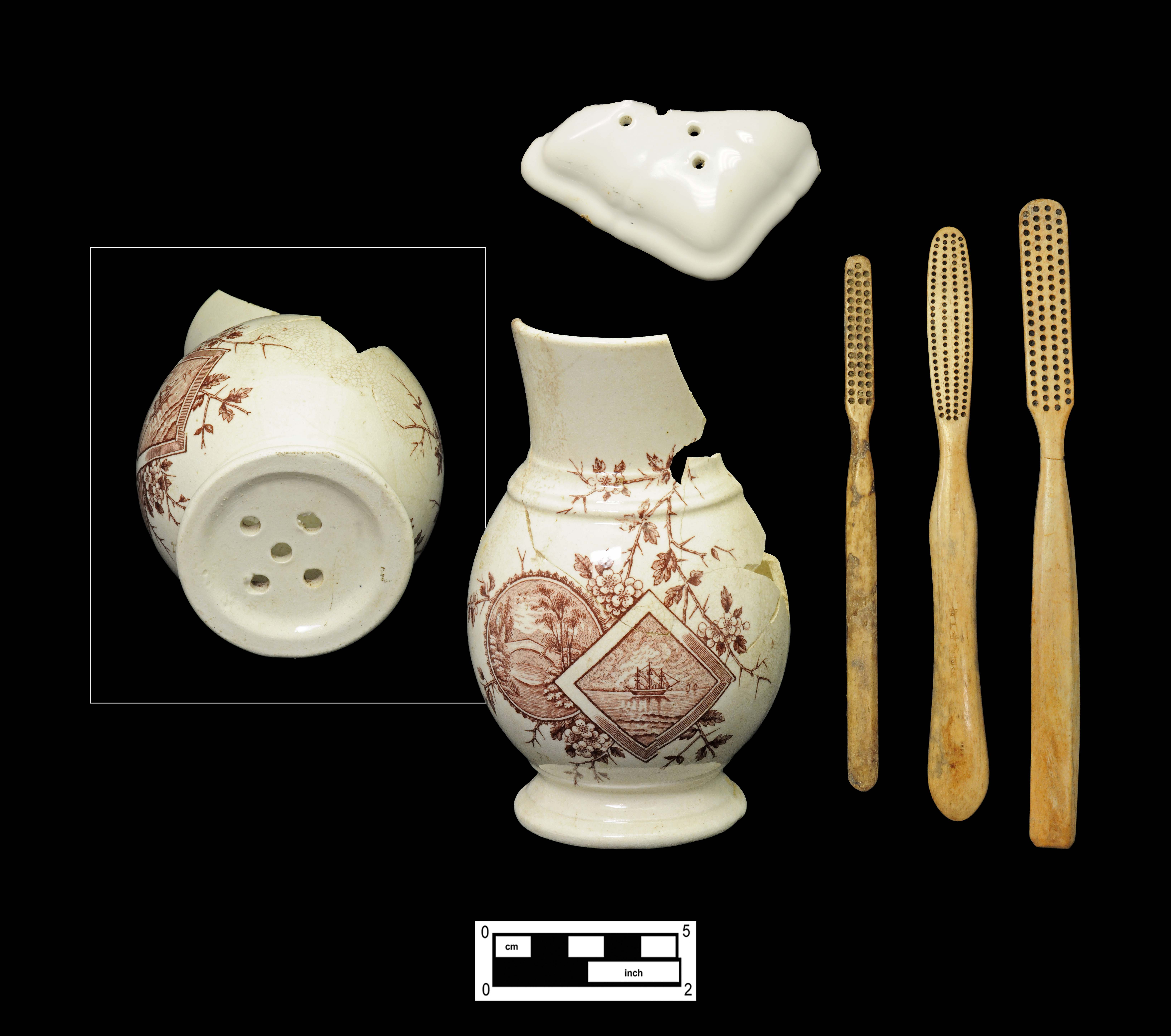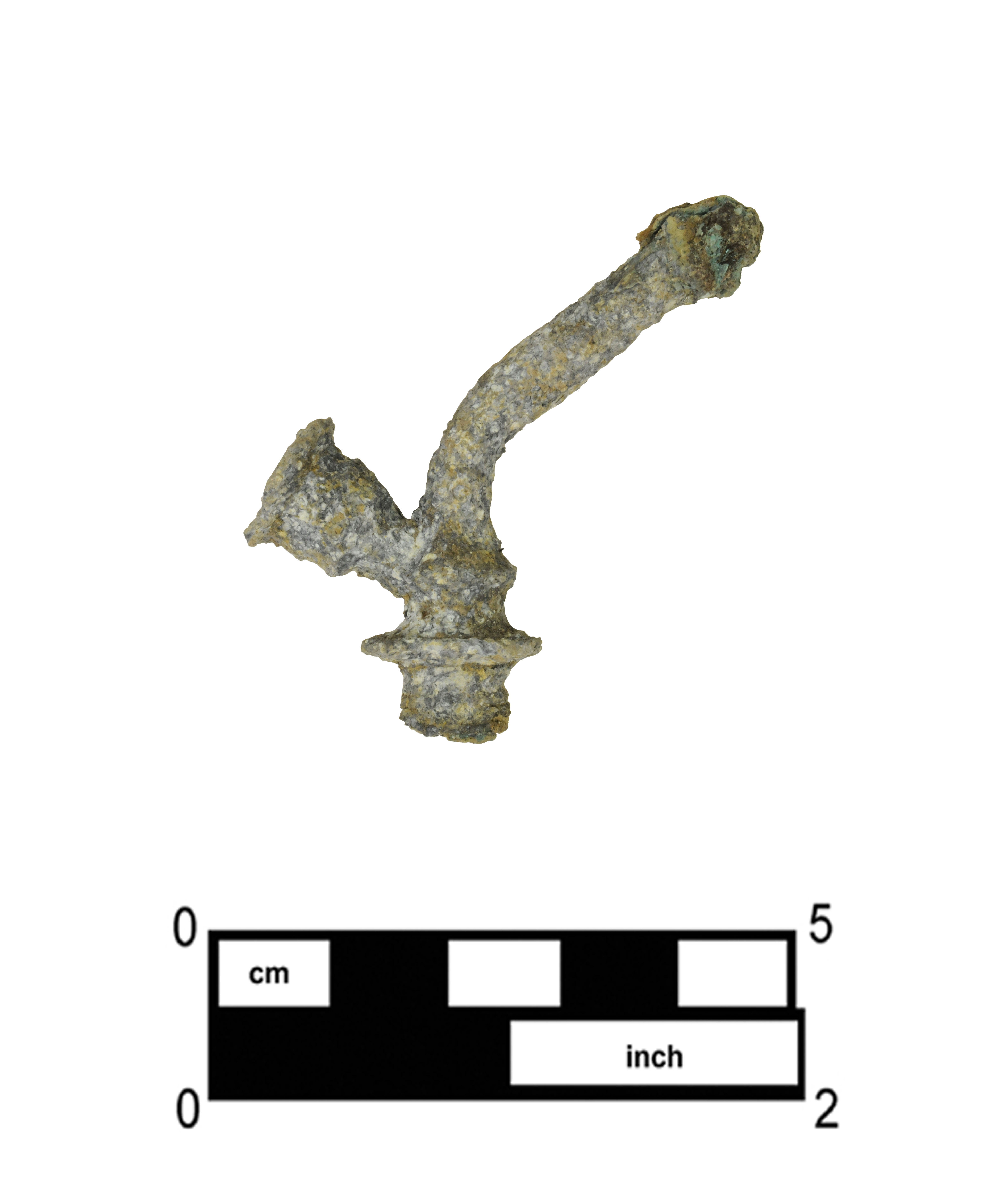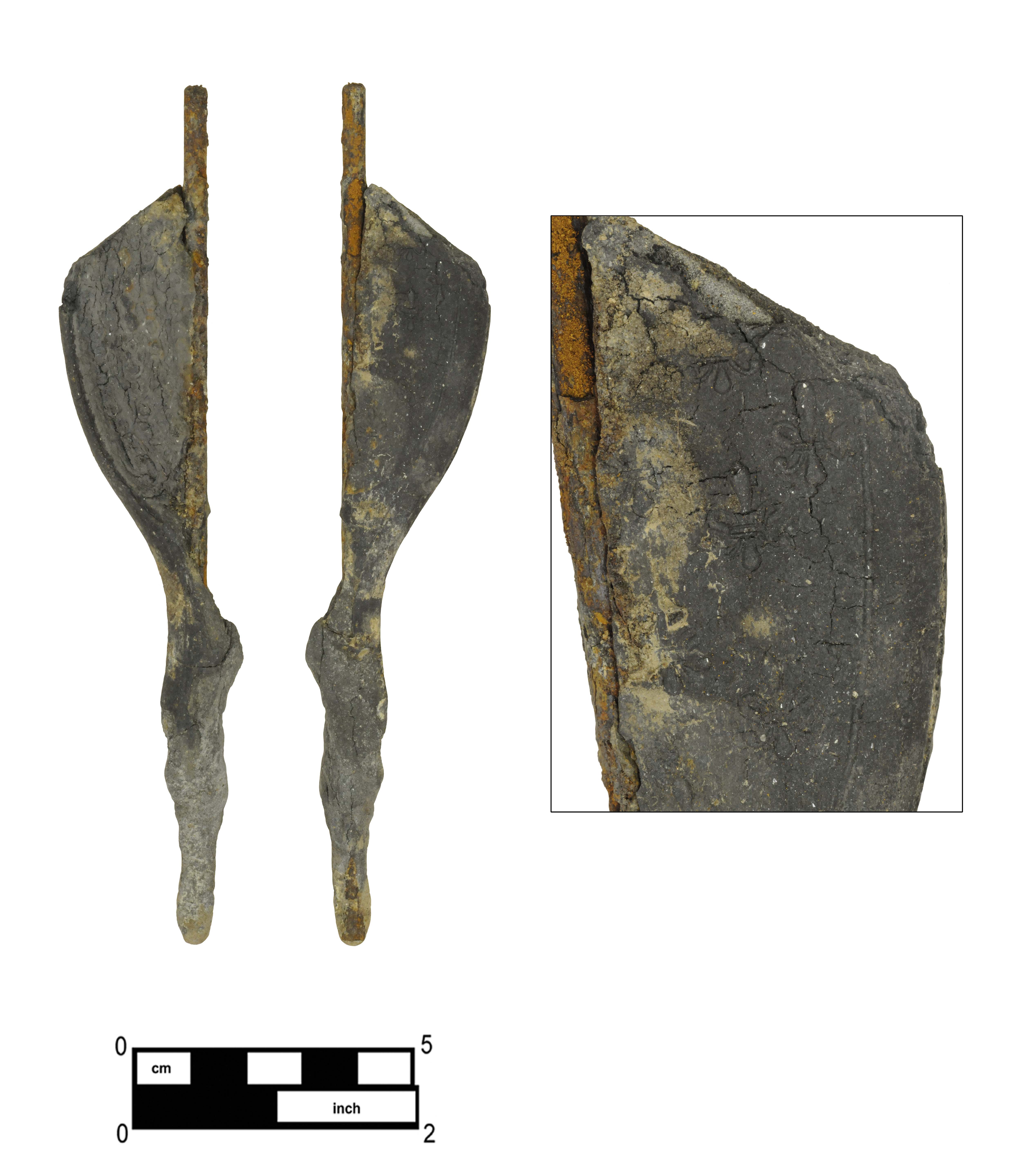Several artifacts related to oral hygiene and grooming are among the noteworthy items from Feature 1.
Toothbrushes and Containers
Among the dental hygiene artifacts recovered were a nearly complete toothbrush vase (Cat # 8.31.10), a piece of the lid from a ceramic toothbrush box (Cat # 8.31.162), and three toothbrushes (Cat # 8.30.101, 8.31.270, 8.31.269). The handles of toothbrushes were often made of animal bone, while bristles were made of boar’s hair. The Montgomery Ward & Company catalog of 1895 provided “hints for use and care of toothbrushes,” and some reference the issues of moisture: “Never lay a wet brush away, but put in an open dish… bristles will be injured if brushes are put away wet and left for several days to dry.” 1

Both styles of toothbrush container were designed to allow residual water to drain away from the brushes. The toothbrush vase enabled the brushes to stand on the edge of the handle and exposed the bristles to air. The base of this brush vase was perforated with five holes to enhance drainage and would have likely had a matching saucer to catch the draining water. Toothbrush boxes usually contained two ledges on the interior for brushes to rest above the moisture that drained to the bottom of the box. The recovered fragment is a portion of the lid from a toothbrush box with small round perforations to allow the bristles to air dry.
Although the toothbrush box lid is undecorated, the brush vase features a dark red printed motif on an ivory refined earthenware body, and the Old Hall Earthenware Company, Ltd.—of Hanley, Staffordshire, England—likely produced it sometime between the mid-1860s and 1886. Known as the “Baltimore” pattern, the motif on this holder features a backdrop of Quince blossoms and thorny branches behind two cartouches. The square cartouche frames a masted ship, while the circular cartouche surrounds a scenic view focused on an arched bridge. The printed pattern and overall composition of this vessel is typical of the Aesthetic Movement of the late Victorian period, particularly the color scheme and asymmetrical arrangement of the blossoms and branches.
The smallest of the three toothbrushes (left) is made of bone and features a rounded square stock containing three rows of 15–16 holes. The gradual neck of the brush transitions into a straight handle with a rounded base. The handle is octagonal in cross-section and the brush as a whole exhibits slight convex cranking, or curvature. According to Mattick’s classification, this brush is the Philadelphia variety of the England Type, a typology that she dates between 1865 and 1920. 2 Mattick states that this is the most basic form of toothbrush, and that smaller, trepanned examples like this with a gradual neck typically date between 1870 and 1905. 3
The remaining two brushes are both made of ivory, and neither fits any of Mattick’s typologies. The larger ivory brush (right) features a rounded square stock with four rows of 20–21 holes and a gradual neck, a straight handle with a squared base, convex cranking, and is octagonal in cross-section. The brush in the center is the most unique of the three, featuring an elliptical stock with four rows of 27–28 holes and a gradual neck, a pinched handle with a teardrop base, convex cranking, and is a pointed oval in cross-section. The latter brush also bears Japanese characters on its handle shaft, as well as the word “JAPAN” near its base.
While the Japanese began to manufacture toothbrushes for their own military as early as 1874, Japanese toothbrush companies did not begin exporting their products until about 1889, when the Completion of Work Company first sent samples of its brushes to the United States. 4 The word “JAPAN” on the handle of this brush could also aid in dating this brush’s production, as the McKinley Tariff Act of 1890 required the labeling of imported goods with their country of origin in English. The enforcement of this specific regulation began in March 1891, thereby providing the earliest production date a production for this brush and making it a likely possession of the Steinmeyer family, who occupied the property from 1887 onward.
The Japanese toothbrush is the only artifact related to dental hygiene that can be directly attributed to a specific family that occupied the property, as the remaining objects were produced from the last quarter of the nineteenth century into the early twentieth century—making them possible possessions of the McCaulley (1864–1882), Cotter (1882–1887), and Steinmeyer (1887+) families.
Atomizer

The long curved nozzle on this white metal atomizer suggests it was intended for directing the application of medicine (Cat # 8.31.273). The tip of the spray tube has an acorn-shaped attachment that may have been interchangeable with other tips. The small side port allowed a rubber bulb or section of tubing with a bulb to be attached. This portion of the atomizer would have screwed into a metal cap secured to a glass bottle. The 1886 Bloomingdales catalog shows a similar style of atomizer offered at prices ranging from 25 to 97 cents, but does not provide any description. 5 Atomizers of a similar shape made of hard rubber were advertised for applying medicine to the throat and nasal passages in the 1895 Montgomery Ward & Company catalog. 6 In the 1902 Sears, Roebuck & Company catalog, atomizers with rubber nozzles were offered for “spraying perfume and disinfecting a sick room” in addition to their medical uses. 7
Hard Rubber Hair Combs and “Florence Brush”

Broken sections of two black hard rubber combs were recovered in Feature 1 (Cat # 8.30.102). Neither of the comb fragments provide evidence of a manufacturer’s mark or any ornamentation along the back edge. The more complete of the two combs measures 6.3 inches in length—longer than pocket combs, which generally measured 4 inches. This comb fragment is slightly shorter than the rubber dressing combs advertised in the Montgomery Ward & Company catalog of 1895, which measured 7–8 inches in length. 8
A large fragment of a black hair brush with an embossed fleur-de-lis pattern on the back closely resembles two “Florence Hair Brushes” advertised in the 1895 Montgomery Ward & Company catalog. 9 Littlefield, Parsons & Company reorganized in 1866, forming the Florence Manufacturing Company to produce hair brushes and mirrors from a shellac-based material called Florence compound. 10 The compound was originally developed by predecessor A. P. Critchlow & Company to make the ornamental cases for daguerreotype images. 11 One of the advantages of this brush may have been the addition of a ferrous metal rod to prevent the handle from breaking. The rod was positioned lengthwise inside the brush and is evident projecting from the top edge of the recovered brush. Florence brushes were advertised in the early-twentieth-century Sears Roebuck & Company catalogs, although the illustrations do not show examples in the same fleur-de-lis design. 12
References
- Montgomery Ward & Co., Montgomery Ward & Co. Catalogue and Buyers’ Guide Spring & Summer 1895 (New York, NY: Dover Publications, Inc., 1969), 103. ↩
- Barbara E. Mattick, A Guide to Bone Toothbrushes of the 19th and Early 20th Centuries (United States :Xlibris Corporation, 2010), 43. ↩
- Mattick, Guide to Bone Toothbrushes, 43. ↩
- Mattick, Guide to Bone Toothbrushes, 16. ↩
- Bloomingdale Brothers, Bloomingdale’s Illustrated 1886 Catalog (New York, NY: Dover Publications, Inc., 1988), 68. ↩
- Montgomery Ward & Co. Catalogue, 260. ↩
- Sears, Roebuck, Sears, Roebuck Catalogue, 1902 Edition (New York, NY: Republished by Crown Publishers, Inc., 1986), 456. ↩
- Montgomery Ward & Co. Catalogue, 105. ↩
- Montgomery Ward & Co. Catalogue, 103. ↩
- Historic Northampton, “The Florence Brush Factory: Artifacts from the Pro Brush Company Collection,”accessed May 2016, http://www.historicnorthampton.org/the-florence-brush-factory.html. ↩
- Historic Northampton, “Florence Brush Factory,” accessed May 2016. ↩
- Sears, Roebuck Catalogue, 937. ↩